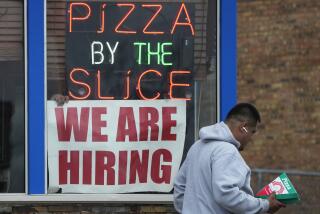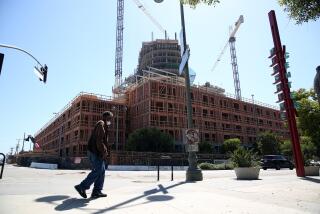Housing Starts Decline for Second Month
- Share via
WASHINGTON — Construction starts on new homes and apartments dropped for a second straight month in April, the Commerce Department said Tuesday, suggesting a slowing but still healthy pace of building activity.
Total starts fell 2.3% to a seasonally adjusted annualized rate of 1.54 million units from a revised 1.58 million in March--a steeper drop than forecast by analysts, who said the pace of building probably peaked in the first quarter.
“We do see some slowdown from the first quarter on,” said economist David Seiders of the National Assn. of Home Builders, with starts for all of 1998 coming in about 2% below last year at 1.45 million new homes and apartments.
“It’s part of the overall economic slowdown we foresee from weaker exports to Asia, reduced business inventory investment and other factors, and housing will join in that slowdown,” he said.
New permit applications also eased for a second month in a row, falling 3.3% to a seasonally adjusted annualized rate of 1.52 million in April after a 4% decline in March.
The report was the final piece of economic data available to Federal Reserve Board policymakers before they met Tuesday to consider interest rates. They voted to leave rates unchanged.
Financial markets focused on the Fed meeting rather than the weaker-than-expected monthly housing data.
Construction starts in the West fell 5.6% to an annualized rate of 370,000 during April. Starts in the Northeast fell 7.1% to 131,000, and in the South they were down 2.8% to 692,000.
Nationwide, April housing starts were the slowest since an annualized 1.52 million in November, but they remained 3.9% above the rate a year earlier, in April 1997, when starts were running at 1.42 million a year.
Housing has been one of the strongest sectors of the economy, fueled by strong job growth and rising incomes and by favorable mortgage rates. The April drop in starts was concentrated in apartments, where starts dropped 13.4% to 297,000 a year after a 2.8% March decline.
Starts on single-family homes rose 0.7% to an annualized rate of 1.24 million after a 2.5% drop in March. The single-family sector of the market constitutes about 80% of total U.S. housing activity.
Economist Ken Mayland of KeyCorp in Cleveland zeroed in on the increase in single-family home-building during April, saying that will generate consumer spending on furniture and furnishings that will help keep the economy growing.
“Without question, residential investment will again show close to double-digit growth in the second quarter, thereby making an important contribution to the continuation of the economy’s above-trend rate of expansion,” Mayland predicted.
The falloff in overall starts during April was evident everywhere except the Midwest, where they gained 4.5% to 345,000 a year.
Seiders said home builders remained optimistic about the potential for construction markets and would probably welcome some slowing from the hectic pace of the first quarter.
“All the problems that I hear about are related not to demand but to the difficulties of being able to get labor and materials, particularly cement,” Seiders said.
(BEGIN TEXT OF INFOBOX / INFOGRAPHIC)
Housing Starts
Seasonally adjusted annual rate, millions of units:
April: 1.54 million
Source: Commerce Department
More to Read
Inside the business of entertainment
The Wide Shot brings you news, analysis and insights on everything from streaming wars to production — and what it all means for the future.
You may occasionally receive promotional content from the Los Angeles Times.










